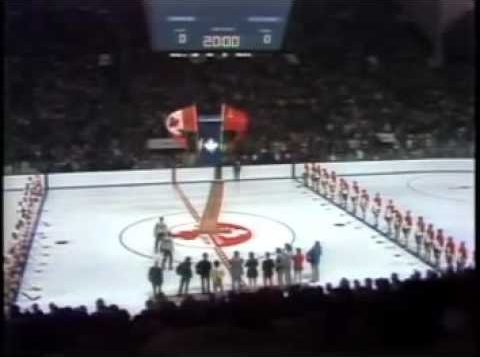This Day in Hockey History – July 12, 1972 – National Team from the National League
In 1972, two hockey superpowers had something to prove and in April developed the idea of playing each other that September to make their hockey prowess known across the globe. The Soviet Union had just won nine consecutive World championships and in the process, the last three Olympic gold medals. However, Canada (whose national identity is tied up in being the birthplace of hockey) was not allowed to send its professional players into international competitions like that. Everyone was about to find out how the world champions and NHL stars compared. In order to do so, on July 12, Canada chose its representatives.
Team Canada’s coach, Harry Sinden, introduced the “35-man super squad” at Sutton Place in Toronto. In selecting the team members, Sinden’s primary strategy was to find the right balance. “When we sat down to do this, we recognized that all the great teams had one thing in common – balance. That was our criterion. We passed up some publicity-prone players in favor of the men we needed to round it out.” He further explained, “Some of the players were selected specifically to fill out a line. . . . Some players may play all eight games, some only one. There’ll be different conditions for each game. We want the right measure of offence and defence, finesse and aggressiveness, youth and experience.”
His other tactic was to make sure the lines had at least some familiarity with each other. For that reason, he kept the New York Rangers’ GAG line (of Jean Ratelle, Rod Gilbert, and Vic Hadfield) completely intact. The Montreal Canadiens’ Mahovlich brothers (Pete and Frank) and Yvan Cournoyer would form another line. He planned to put Phil Esposito and Wayne Cashman of the Boston Bruins on a line with Richard Martin of the Buffalo Sabres. Similarly, he was thinking Detroit’s Red Berenson and Mickey Redmond could share a line with J.P. Parise of the Minnesota North Stars. The other potential line would consist of Buffalo’s Gilbert Perreault, Minnesota’s Bill Goldsworthy, and Paul Henderson of the Toronto Maple Leafs.
The defensemen would also pair with teammates. The intended pairing included: Brad Park and Rod Seiling of the Rangers, J.C. Tremblay and Jacques Laperriere of the Canadiens, Bill White and Pat Stapleton of the Chicago Blackhawks, and Bobby Orr (who ended up missing the series due to knee injuries) and Don Awrey of the Bruins.
Finally, Sinden already planned to have Montreal’s Ken Dryden man the net for the series opener. Chicago’s Tony Esposito would serve as backup. Although it seemed unlikely that he would qualify, Sinden also chose Boston’s Gerry Cheevers as the third goalie.
Overall, the roster featured three goalies, twelve defensemen, and twenty forwards. The teams with the most representation included the Canadiens (with seven players), the Bruins (with six), and the Rangers (with five).
Of course, the lines were subject to change in training camp (to be held at Toronto’s Maple Leaf Gardens), and they were only allowed to take 30 players when traveling. In addition, there was a major restriction to the eligibility of the men on the roster. In order to play in the 1972 Summit Series, each player had to sign an NHL contract for the 1972-73 season before training camp started on August 13. The NHL owners had only agreed to allow their players to participate under the condition that only NHLers could play, and President Clarence Campbell and Chicago’s owner Bill Wirtz remained firm on that point.
Some of those on Sinden’s roster had not yet signed with the NHL. As Park remarked, “It puts me under extra pressure. But I can quickly turn that around. Don’t you think the front office would feel some heat if I can’t play because they’re haggling over a few dollars?” As it turned out, four of the chosen 35 were barred because they instead signed with the new rival league, the WHA. By the time the list came out, Bobby Hull had already accepted a $1 million signing bonus with the Winnipeg Jets, and Cheevers was finalizing talks with Cleveland Crusaders. Tremblay and Derek Sanderson were the other two who chose the WHA over the NHL and Summit Series.
The eight-game series would begin at Montreal on September 2 then continue westward across Canada with games at Toronto, Winnipeg, and Vancouver. The Russian half of the series would begin in Moscow on September 22. Between, they scheduled exhibition games against Sweden and Czechoslovakia in Prague. Partly due to overconfidence approaching the series, Team Canada lost three of the first five games. Thanks to Henderson’s game-winners, they came back to win the final three games and the series.
Additional Sources:
- Mike Commito, Hockey 365: Daily Stories from the Ice(Toronto: Dundurn, 2018), kindle edition.
- Ted Blackman, “NHL brass blocks Bobby Hull’s shot at Russia,” Montreal Gazette, 13 July 1972, p. 1.
- Ted Blackman, “Sinden: Dryden’s his man in opener,” Montreal Gazette, 13 July 1972, p. 25.















[…] https://thepinkpuck.com/2019/07/12/this-day-in-hockey-history-july-12-1972-national-team-from-the-na… […]